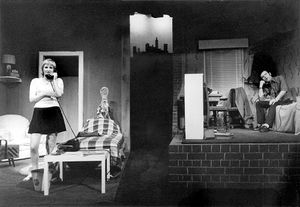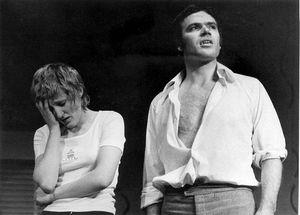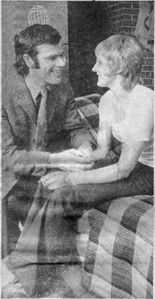Two for the See-Saw (1973)

Designed & Directed by Michael Small
Performances: June 1973, Theatre
Contents
Introduction
The action takes place between autumn and spring, in two rooms - Jerry's and Gittel's - in New York city.
Cast
- Jerry Ryan - Ray Jones
- Gittel Mosca - Sally Davies
Crew
- Stage Manager - Christine Crow
- Assistant Stage Manager - Glyn Putwain
- Props - Margaret Benjamin
- Lighting - Tony Rapson
- Sound - Gordon Scott
- Production Assistants - Brenda Johnson, Christine Wilson & Sheila Saxon
- Set Construction - Bernie Bullbrook & Peter Davies
- F.O.H. Manager - Frank Howcutt
Reviews
"Nearly Dead Inside"
As an old TV series told us, there are eight million stories in New York City. Gibson's "Two for the See-Saw" is one of them. It charts the eight-months-long affair of Jerry Ryan and Gittel Mosca from probing hello to elegiac farewell.
Whether we ever truly get inside the skulls of these sad and lonely people is an open question. The dominant organ - for this is a case history in more senses than one - is Gittel's stomach. Indeed, it is exactly 12 years since I last saw the play, and I still tend to identify the actress who then played the role with the haemorrhage of the second act. When I saw her recently, I caught myself being faintly surprised that she seemed as fit as a fiddle. Thus do playwrights and actresses work their art.
South London Theatre Centre rather relish the challenge of the two-hander, and Michael Small's production this week has integrity and sensitivity in equal measure. Sally Davies, who recently gave such an impressive performance as the deaf-mute Belinda in a tear-jerker by Elmer Harris, here confirms her reputation as one of the brightest young actresses in the company. At the other end of the see-saw, Ray Jones gives a portrayal of matching power. Jerry is an attorney with the outward promise of a bright career. But he is nearly dead inside, floundering on the wreckage of a marriage to a rich and consuming wife.
The course charted by these two is a bumpy one, and in the acting sense it is a little uneven also. The lay seems just that bit too long, and the protagonists are not quite able to sustain the intensity of the haemorrhage scene.
But the relationship, take it for all in all, is built up, brick by emotional brick, with rare skill. Ray Jones' accent may at times suggest Old Coulsdon rather than New York, but that is a small matter.
They respond to each other, drawing strength from their mutual dependence, transcending the fierce quarrels with shards of vulnerablilty. I can think of no other pair at the Centre who could have come closer to total conviction. It is enough.
Donald Madgwick, The Croydon Advertiser.
Gallery
- Photos by Bim Harding - not fully restored
Reminiscences and Anecdotes
Members are encouraged to write about their experiences of working on or seeing this production. Please leave your name. Anonymous entries may be deleted.
See Also
Have there been other SLTC/SLT productions of this play? Link to them here.
Or add anything that is related within this site. The author's page for instance or other plays with a similar theme.
References
<references/>



